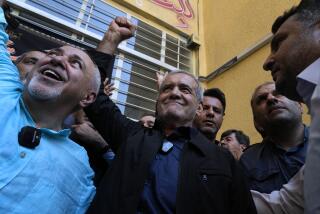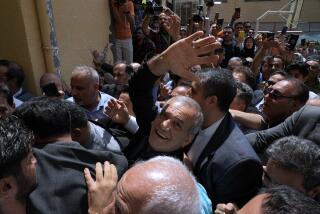In Iran, it’s supreme leader only up to a point
BEIRUT — Iran’s supreme leader spoke not with the thunder of a man regarded in his country as God’s representative on Earth, but with the exasperated tone of a corporate manager chastising his employees.
Ali Khamenei had ordered his deputies to start privatizing state-owned businesses: the telephone company, three banks and dozens of small oil and petrochemical enterprises.
Jealously guarding their own sources of power and patronage, however, his underlings all but ignored him.
Months passed. Then Khamenei gathered the country’s elite for an extraordinary meeting. President Mahmoud Ahmadinejad and his Cabinet ministers were there, as were important clerics, the leader of parliament and provincial governors, and the heads of state broadcasting and the Iranian chamber of commerce.
With television cameras rolling, Khamenei told them to pass some laws, sell off some businesses -- and be quick about it. “Those who are hostile to these policies are the ones who are going to lose their interests and influence,” he declared.
The system shrugged. By November, nine months after his public scolding and almost a year and a half after Khamenei had first issued his order, almost nothing had happened. According to the Middle East Economic Digest, only two out of 240 state-owned businesses Khamenei targeted had been sold off.
For years, Western analysts have struggled to understand the inner workings of Iran’s leadership. To many, it is a government tightly controlled by the Shiite Muslim clergy. But the power of the clerics has steadily eroded. Increasingly, power is distributed among combative elites within a delicate system of checks and balances defined by religious as well as civil law, personal relations and the rhythm of bureaucracy.
Iran analysts struggle to discern which officials have authority and how much. And when Iranian officials make public pronouncements, it often is unclear whether they are expressing established policy or fighting among themselves -- speaking for their own faction or just themselves.
Concentric circles of influence and power that emanate from the supreme leader include the clergy, government and military officials -- and at their farthest fringes, militiamen and well-connected bazaar merchants -- altogether perhaps 15% of Iran’s 70 million people.
Even the man regarded in Iran as the highest-ranking cleric in Shiite Islam finds himself constrained and challenged.
Those inside Iran’s circle of power, says Ali Afshari, an analyst and former student activist now living in Washington, operate according to unique rules.
“It is not a democracy or an absolute totalitarian regime,” he said. “Nor is it a communist system or monarchy or dictatorship. It is a mixture.”
--
Those who matter
In the parlance of Iran’s ruling elite, those who truly matter are referred to as khodi, Persian for “one of us.”
Khodi accept that Khamenei has a God-given right to rule. At least outwardly, they adopt the values of the senior clerics. They even adhere to a dress code: The men wear white shirts buttoned up to the collar; gray, brown or black suits; and neatly trimmed beards -- the garb of the traditional merchant class. The women wear the single-piece black chadors covering all but their hands and faces.
“In our society there is a red line between khodi and non-khodi,” said one political activist. “If you’ve never been on the right side of that divide, you’re considered guilty until proven otherwise. If you’re not khodi, you don’t have the right to criticize.”
Khamenei and his closest advisors are at the center of that power structure, overseeing grave matters of state, including the country’s nuclear program and domestic policy, from a huge tree-shrouded compound in downtown Tehran. Each day, the Supreme National Security Council, Khamenei’s main think tank, faxes his orders to newspapers, television stations and government officials. Clergy spread the word at homes and Friday prayer sessions.
Surrounding the supreme leader are several powerful committees consisting of dozens of clerics, each established to cement the central role of religion in Iranian politics. The Council of Experts chooses the supreme leader. The Guardian Council vets laws and candidates for public office. The Expediency Council mediates legal disputes.
Next are the leaders of the Revolutionary Guard and armed forces, who are appointed by Khamenei; the elected president; the Cabinet; parliament; senior military commanders selected by the supreme leader; and the senior clerics in the holy city Qom.
Beyond that are governors and other provincial officials, all approved by the president. At the outer rim of khodi are well-connected merchants, militia members and millions of volunteers who make up the government’s shock troops.
Included in the system are people with different ideologies and agendas, including the offspring of Western universities and onetime operatives in the shah’s intelligence service whom Ayatollah Ruhollah Khomeini needed to help bring down the shah in the 1970s, defend his revolution and withstand attack from Iraq’s Saddam Hussein in the 1980s.
From the beginning, Iran’s leaders fought over how wide to expand the circles of power, and how much room there would be to challenge the leadership.
Even those on the outer fringes of power can buck authority, especially if they retain a rank within the religious hierarchy. Despite a moratorium on stoning those convicted of morality crimes, a judge this year in the western village of Takistan ordered the stoning of a man for adultery.
Instead of firing the official, judiciary chief Ayatollah Mahmoud Hashemi Shahroudi decided the judge had a point: Stoning was, after all, part of Islamic law.
Though ordinary people have limited freedom to criticize the power structure, analysts and officials in Tehran say that the heads of government agencies eagerly devour results of polls about their leaders’ performance and Iranians’ attitudes toward everything from women’s dress to making peace with the U.S. Many of Iran’s leaders fear a popular uprising like the one that toppled the shah or the communist governments of Eastern Europe.
One after another over the past decades, Iranian leaders have tried to control this convoluted system -- and failed.
--
‘Many centers of power’
“There are so many centers of power,” said a Western diplomat in Tehran, who spoke on condition of anonymity. “The system was designed to not let anyone be in total control.”
In 1997, Khamenei watched helplessly as the reformer Mohammad Khatami crushed the supreme leader’s candidate for president.
Despite his political mandate, the new president subsequently ran up against the power of the military and clerical elite. After his government signed a contract with Turkey to run Tehran’s new airport, the Revolutionary Guard swooped in during the ribbon-cutting, shutting the airport and nullifying the deal in a blow to Khatami’s attempts to open the country to foreign investment.
Hashemi Rafsanjani, a senior cleric who heads the Expediency Council, seemed a shoo-in to replace Khatami in 2005. But he was outmaneuvered by Ahmadinejad and lost the election.
Ahmadinejad found himself hemmed in by opposition to his appointees, including the key post of chief negotiator with the international community over Iran’s nuclear program. Parliament has rejected many of his choices.
When Ahmadinejad was elected president in 2005, the urbane cleric Hassan Rowhani was fired as nuclear negotiator and disappeared from the spotlight. But after getting rid of Rowhani, Ahmadinejad was forced to give the job to a detested and well-connected rival, Ali Larijani.
In the meantime, Rowhani has made a political comeback.
Analysts said that despite his reputation as a relative moderate, Rowhani probably managed to get Khamenei’s ear by exploiting the president’s reputation as a populist rabble-rouser who could pose a threat to the supreme leader’s power. He delivered a speech criticizing Ahmadinejad’s authoritarian style and began appearing regularly on the front pages of state-run newspapers.
“The country is no one’s property,” he said. “The notion that someone owns the country and its people is our biggest problem and incurable disease.”
That same week, Khamenei made a speech saying that no one in the government was above criticism, in effect barring Ahmadinejad from attacking Rowhani and blessing his return to Iran’s innermost circle of power.
When Larijani quit this year, the president appointed his own man, Saeed Jalili, as nuclear negotiator -- at least until an advisor to Khamenei complained. Both Jalili and Larijani attended the next round of negotiations with European officials.
Ahmadinejad even has had to rescind some orders on relatively minor issues.
Last year, he extended Eid al-Fitr holidays and eliminated daylight saving time. But people complained loudly of missed international flights and too many days off. The man who challenged Iran’s most powerful clerics bowed to public pressure. This year the calendar went back to normal.
--
No mandate on economy
Khamenei has found that even if the power structure believes he has a mandate from heaven, he can’t make it move on economic reforms.
Iran needs to free up billions of dollars from its budget to invest in its ailing oil industry, the source of half of the government’s income. However, hundreds of money-losing state-owned enterprises drain the budget. Despite the high cost of oil, the World Bank predicts that Iran will be running a deficit in two years.
Privatization would help raise funds, but it would mean wresting lucrative patronage from the hands of religious foundations, military institutions and well-connected bazaar khodi.
“Khamenei is currently surrounded by intelligence forces, the Revolutionary Guards and the hard-line media,” said Mohsen Sazegara, a former Iranian official and onetime khodi who is now a vehement critic and lives in Washington. “They pretend to listen to Khamenei’s orders, but they do whatever they want.”
Since the 1979 revolution, state-owned factories have been used as recruiting and fundraising centers for Basiji militiamen, who answer to the Revolutionary Guard. They provide jobs for the relatives of government loyalists. One aluminum factory in central Iran provides jobs for relatives of local officials of the Ministry of Intelligence and Security, said a Tehran economist who spoke on condition of anonymity.
The businesses Khamenei wants to sell on the stock market also are expected to kick in millions of dollars each year for political and religious events that are part of the Islamic Republic’s ideological machinery.
“They ask you politely, ‘How much will you donate for the revolution festivities?’ or, ‘How many workers will you release to participate in the rallies?’ ” said one executive at an Iranian company.
Managers have found other ways to thwart the privatization plan. After shares of a state-owned aluminum company failed to sell this year, executives removed the offering rather than lower the price.
“There’s a very large group of managers who don’t want this to happen,” said Moussa Ghaninejad, an economist and journalist at Donya Eghtesad, a business newspaper. “They create so many problems that it doesn’t get done.”
Sometimes, senior officials intervene to halt a sale. Ahmadinejad stopped a recent effort by an Iranian industrialist to buy a state-owned carmaker’s share in a private bank.
In a lead editorial, Kayhan, a newspaper representing the views of the conservative leadership, demanded that non-khodi be cut off from the public wealth. Khamenei’s own mouthpiece was subverting his goals.
“If you ask me, ‘Who is running Iran?’ ” said one Tehran trial lawyer, “I would say, ‘Everyone -- and no one.’ ”
--
More to Read
Sign up for Essential California
The most important California stories and recommendations in your inbox every morning.
You may occasionally receive promotional content from the Los Angeles Times.










